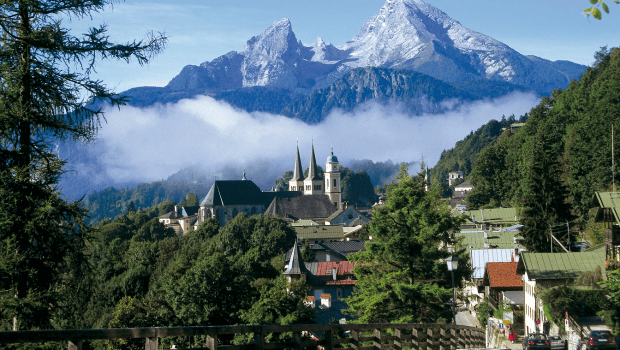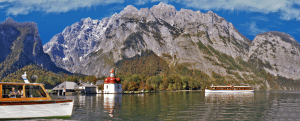
Berchtesgaden is truly a town of views and sceneries. It is often known as the land at the foot of Mount Watzmann . With the majestic Bavarian Alps surrounding it on all sides, it is located near the “Eagle’s Nest”. Along with its spectacular picturesque setting, Berchtesgaden is also famous for its salt mines.
Its setting is nothing less than that of a fairy tale. Berchtesgaden is drenched in century’s worth of history and decorated with multitudes of facades, churches, and the Royal Palace. It is also home to the Holy church of Maria Gern. Most of the region falls under the Berchtesgaden National Park and thus is protected by law. UNESCO had declared this park as a ‘biosphere reserve’ in 1990.
Location:
It is situated right inside the German Bavarian Alps in a valley. The high mountains that surround Berchtesgaden in the north are called: Untersberg, in the east they are known as Obersalzberg, and the one in the southern region are called: Watzmann.
It is located in the southern district of Berchtesgadener Land in Bavaria. This region borders with Austria and is situated at a distance of 180 kilometres form Munich and about 30 kilometres from Salzburg.
Climate:
The paradise city of Berchtesgaden has a typical alpine climate. The winters are cold with the daily highs reaching -5 degree centigrade during night time; on the other hand days remain quite sunny. The magnificence of the high alpines surely would blow your mind away especially during winters.
Spring days might still be a time for snuggling and laying around with temperatures reaching 9 degree centigrade but the night time yet remains freezing. It starts getting warmer April onwards when the temperatures reach 14 degree centigrade. During May the days average at 18 degrees and the nights reach as low as 7 degree centigrade. Hikers come out of their shells and get on their adventure mode doing this time of the year.
Summers remain pleasant as the temperature would only reach the highs of 24-25 degree centigrade during the day time and nights remain comfortable at 16 degrees. Also it rains a lot here during summers so be prepared with your gears. Furthermore, explorers and tourists prefer this time of the year.
Autumns are probably the most picturesque as it is during this time that the alpine foliage transforms and changes colour. The air also becomes slightly misty. The average highs are around 17 degrees centigrade and it falls further in October and November.
History:
The first ever mention of Berchtesgaden was found in records that dated back to 11th century. This was made in reference to its rich salt deposits. Moreover, the economic growth of the region is thus based on its salt. Interestingly salt mining in the region started in the year 1517.
Furthermore, it was since 1491 that Berchtesgaden became or held the status of being semi-independent within the German Empire. The Napoleonic wars are responsible for the secularisation of the area. Furthermore, when the Treaty of Pressburg was signed in 1805, the region was ceded to Austria and Berchtesgaden first changed hands. It was also under the occupancy of Salzburg and that of the French army as well for a while. Furthermore, the Bavarian family first took control of the region in 1810 and it thus became their favourite, the jewel of their crown.
As tourism and travel started to develop, Berchtesgaden became host to a number of artists and writers. The famous German writer Ludwig Ganghofer was also known to have spent many of his days here. Artists would ponder endlessly and a tradition of “literally painter’s corner” began here.
The city:
Among the many reasons to visit this city, the most important ones are just to experience its cultures and traditions. The city and its people live by many traditions and folklores and each new generation seems to fluidly incorporate everything within its own countenance.
The city offers many original Bavarian eateries along with the ones that offer other popular cuisines. The few “must try” specialities should include: Knödel, Schweinehaxe, Bratwurst, Leberkase, Weisswurst, Kartoffelsalat, Gulasch Bratkartoffeln, and Kaiserschmarn, etc. Make sure you also try the locally made wheat beer. Also, there is no dearth of accommodations or hotels. You can find places for all budget options.
The city comprises of a network of narrow, winding streets and some very gorgeous looking pastel houses built in the traditional alpine style. To explore the city you must be on foot or rent a bike.
Reaching Berchtesgaden is not difficult at all. If you are travelling by train, then it becomes quite convenient. Train connections are available from Munich, Innsbruck, Vienna and Salzburg
In case you are travelling by air then the closest airport is located at Salzburg (about 20 km). Another major airport is Munich Airport (about 180 km). Both these airports are capable of shuttle bus transfer facilities.
If you choose to travel by car then you’ll have to take the Autobahn or German Alpine Road. Furthermore, travelling within the city is quite easy due to the well-functioning buss system.
Why visit?
In the good old days Berchtesgaden had played host to some of the most prominent nobility of the region including the King of Bavaria. It has been a favourite destination of many artists and writers who would get mesmerised by the charm of the town and the alpine sceneries. This Alpine jewel has to be a must in the bucket-list of all travel junkies.

Major attractions:
- The historic Rococo town centre and its colorful facades.
- Almbach Gorge & Marble Mill: It is Germany’s last marble ball grinding mill which has been in operation since 1683.
- Royal palaces: There are guided tours available to experience the Royal Palace. This Palace has gone through many historical changes and evolved over time and interestingly each of those changes has been immortalized within the building.
- Mount Jenner: This is popular because of its scenic beauty and also because 100 German and Austrian peaks can be viewed from here.
- A guided historical tour by the ”night watchman” a lovely way to expertise Berchtesgaden.
- The Berchtesgaden National Park: It was established in the year 1978 and is quite popular among the locals and tourists.
- Salzbergwerk: These are the salt mines
- Kehlsteinhaus: Known as the “Eagles Nest”. This is in-fact most popular among the tourists. It is an edifice belonging to the Third Reich era and is located on top of the Kehlstein. It was presented to Adolf Hitler on his 50th But, today it serves as a restaurant and beer garden which is open seasonally.
- Dokumentationszentrum Obersalzberg: A museum which is dedicated World War II. You can find chronicles from the War.
- Skiing and Luging: The town plays host for many national and international skiing and luging competitions. Moreover, tourists can find many spots for the sports. The International Luge Federation (FIL) is also located in the city. You can also snowboard at the Gutshof and Rpssfield ski areas.
- Other form of sports: Hiking, golf, tennis, summer sledding, ice-skating, cross-country and downhill skiing.
- Lake Königssee: It is famous for its emerald green water and the alpine view. There are facilities to cruise or get on row and power boats.
- Lake Hintersee: Another site worth visiting because of its idyllic and romantic feel.
Other places around:
- Schönau a.Königssee
- Bad Reichenhall
- Munich (3 hours by train)
- Salzburg, home of Mozart (1 hour by train).
